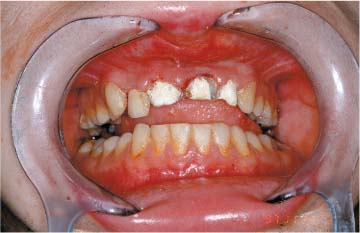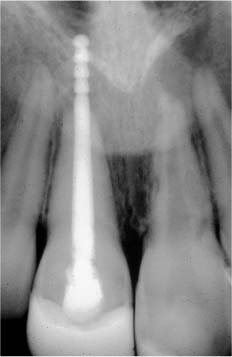22 Treatment of Dental Injuries Whether an injured tooth is worth salvaging depends on an assessment of fracture localization, condition of the marginal periodontium, pulp, apical periodontium (root filling), and dental findings. Usually, there is an indication to save the tooth and thus management. Smaller cracks in the enamel require only smoothing of sharp enamel edges and application of flouride. Larger enamel defects require reconstruction using acid-etch bonding with composite filling. Enamel-dentin fractures without pulp exposure are managed with acid-etch restoration after covering the dentin wound with a calcium hydroxide dressing. Treatment of the dentin wound is particularly important in children and adolescents, as the wide-open dentinal tubules in immature teeth can jeopardize pulpal health. In an emergency, the tooth can be treated with a calcium hydroxide dressing and phosphate cement, possibly with a strip crown, in order to prevent infection of the pulp via the open dentinal tubules (Fig. 22.1). The same procedure applies to enamel-dentin fractures with pinpoint pulpal exposure. Greater exposure with wide open and incomplete root development must be treated with vital pulpotomy of the crown pulp. The pulp wound is covered with a calcium hydroxide dressing. Larger pulp exposure with completed root development is managed with vital pulpectomy, immediately followed by root canal filling. In root fractures in the coronal third, vital pulpectomy and root canal filling can be followed by orthodontic extrusion for root treatment and management with a post and crown. Fig. 22.1 Temporary management of an enamel-dentin fracture of teeth 11, 21, and 22 with calcium hydroxide and cement. In fractures of the middle third of the root with displacement, attempts at salvaging the tooth are difficult. Occasionally, the apical portion of the root can be removed and the tooth crown with the coronal root segment can be secured to the bone through transdental fixation with a titanium or ceramic pin. Additional splinting of the tooth is recommended (Fig. 22.2). In fractures without displacement, an attempt can be made to salvage primary teeth with incomplete root development. The tooth should be splinted for 6–8 weeks. Completion of root development and “healing” of the root fracture have occasionally been observed with dentin apposition. Close follow-up observation is necessary. The tooth must be extracted if pulpal necrosis and inflammatory changes occur. Transdental fixation is rarely successful given that the root pulp is usually still expanded and the correspondingly thin root walls. It is important to temporarily preserve the tooth, at least until cessation of growth, as vertical development of the alveolar process largely depends on the presence of the tooth and periodontal tissues, which exert tensile forces on the bone. Fig. 22.2 Transdental stabilization of tooth 11 with a titanium pin. Teeth with intraalveolar root fractures in the apical third can usually be salvaged. Connective tissue healing may occur with nondisplaced fractures. If there is pulpitis, pulpal gangrene, or apical periodontitis, the tooth must undergo trephination. Root canal therapy and root canal filling are necessary. The fractured apical third of the root should be removed during resection of the root tip. In fractures of the apical third of the root with displacement and luxation of the larger fragment, the tooth must be immediately repositioned and splinted. Resection of the root tip and root canal filling of the remaining tooth must be done immediately in the same intervention, or at the latest before splint removal. In longitudinal fractures of the tooth root, single-root teeth cannot be salvaged. In fractured molars with favorable fracture lines, sometimes one root can be preserved after hemisection of the tooth. If tooth extraction is mandated, it should be determined whether orthodontic space closure is indicated or whether the tooth should be replaced with an implant. Frontal incisors can also be replaced with bridgework or removable dental prostheses. If the neighboring teeth are healthy, they must be ground down for placement of the bridge abutments. Exposure of the vestibular alveolar wall is achieved either through a gingival margin incision or a curvilinear incision based on Partsch at the border between the free and attached gingiva. Surgical access is often dictated by the injury site in the marginal gingiva. After resecting the buccal cortical bone, the fractured root tip or apical third of the root is excised. The root canal is prepared and filled with a suitable filling material. For further details, consultation of endodontology or oral surgery textbooks is advised. Sutures are removed after 6–10 days. Tetanus vaccination status must be checked in all patients with dental fractures with associated gingival injury. Wound contamination, pulpal necrosis, abscess, tooth loosening, and sequestration are typical complications. Rules and Pitfalls
 Table 3.7, Checklist Dental Injuries, Chapter 3, p. 24.
Table 3.7, Checklist Dental Injuries, Chapter 3, p. 24.
 Antibiotic Therapy, Chapter 24, p. 210.
Antibiotic Therapy, Chapter 24, p. 210.
 Diagnosing Dental Injuries, Chapter 12, p. 112.
Diagnosing Dental Injuries, Chapter 12, p. 112.
Treatment of Dental Injuries
 Diagnosing Dental Injuries, Chapter 12, Tooth Fractures, p. 112.
Diagnosing Dental Injuries, Chapter 12, Tooth Fractures, p. 112.
Indications
Conservative Treatment of Crown Fractures
Enamel Fractures
Enamel-Dentin Fractures without Pulp Exposure
Enamel-Dentin Fractures with Pulp Exposure
Surgical Management of Root Fractures
Coronal Third Root Fractures
Middle Third Root Fractures
Apical Third Root Fractures
Longitudinal Fractures
Approaches (Resection of the Root Tip)
Surgical Technique
Complications
 Dental fractures with and without pulp exposure are painful. The teeth are extremely sensitive to cold and warm stimuli. After determining sensation in the affected teeth with a refrigerant spray, further evaluation or treatment continues under local anesthesia.
Dental fractures with and without pulp exposure are painful. The teeth are extremely sensitive to cold and warm stimuli. After determining sensation in the affected teeth with a refrigerant spray, further evaluation or treatment continues under local anesthesia.
Stay updated, free articles. Join our Telegram channel

Full access? Get Clinical Tree




